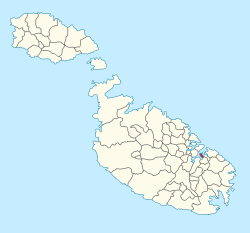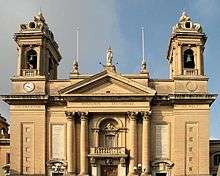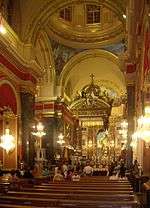Senglea
| Senglea L-Isla Città Invicta, Civitas Invicta | |||
|---|---|---|---|
| City and Local council | |||
|
From top: Skyline, typical street, Parish Church, Gardjola, Land Front | |||
| |||
|
Motto: Civitas Invicta (Belt Qatt Mirbuħa) (Unconquered City) | |||
 | |||
| Coordinates: 35°53′16″N 14°31′1″E / 35.88778°N 14.51694°ECoordinates: 35°53′16″N 14°31′1″E / 35.88778°N 14.51694°E | |||
| Country |
| ||
| Region | South Eastern Region | ||
| District | Southern Harbour District | ||
| Borders | Cospicua | ||
| Government | |||
| • Mayor | Joseph Casha (PL) | ||
| Area | |||
| • Total | 0.2 km2 (0.08 sq mi) | ||
| Population (March 2014) | |||
| • Total | 2,784 | ||
| • Density | 14,000/km2 (36,000/sq mi) | ||
| Demonym(s) |
Senglean (m), Sengleana (f), Sengleani (pl) Isolan (m), Isolana (f), Isolani (pl) | ||
| Time zone | CET (UTC+1) | ||
| • Summer (DST) | CEST (UTC+2) | ||
| Postal code | ISL | ||
| Dialing code | 356 | ||
| ISO 3166 code | MT-20 | ||
| Patron saint |
Marija Bambina Christ the Redeemer | ||
| Day of festa |
8 September Third Sunday of June | ||
| Website | Official website | ||
Senglea (Maltese: L-Isla [ˈlɪslɐ]), also known by its title Città Invicta (or Civitas Invicta), is a fortified city in the South Eastern Region of Malta. It is one of the Three Cities in the Grand Harbour area, the other two being Cospicua and Vittoriosa, and has a population of slightly below three thousand people. The city's title Città Invicta was given because it managed to resist the Ottoman invasion at the Great Siege of Malta in 1565. The name is Senglea since the Grand Master who built it, Claude de la Sengle, gave this city a part of his name.
History
.jpg)
The island on which Senglea lies was joined by a land bridge to Cospicua during the time of the Knights of St. John and as a result, it became peninsular in shape. During the time of the Knights of St. John, Senglea was also used as a hunting area, and was known as L'Isola di San Giuliano.
In 1311 St. Julian's church or chapel was founded in Isola. This was the first building to be constructed on what later became Senglea. On 8 May 1552 the foundation stone of Fort St.Michael was laid. Work on the fort, which was designed by Architect Pedro Pardo, was completed in 1553. Construction of walled town Senglea took place during the following decade. The area, which had until the 1550s been known as Isola di San Giuliano or Isola di San Michele, was given city status by Grand Master Claude De La Sengle and was named after him.[1]
Senglea played an important role in the Siege of Malta in 1565 and remained unconquered. The city was given the title Civitas Invicta (meaning "Unconquered City") by Grand Master Jean Parisot de Valette. In 1581 Senglea became a Parish dedicated to the Nativity of Our Lady. The donation of the statue of Our Lady, popularly known as "Il-Bambina", is estimated to have occurred in 1618. Many inhabitants of the city were killed in an outbreak of plague which affected Malta in 1676.[1]
In 1798, Senglea was involved in the blockade against French forces, who were ousted from Malta in 1800. The city narrowly escaped being hit by another plague in 1813; a statue of Our Lady was erected in the city's centre as a sign of gratitude.[1]
The parish church was bestowed with the title of Basilica by Pope Benedict XV in 1921. Senglean-born Ignazio Panzavecchia was elected as the first Prime Minister of Malta in the first Self Government Constitution in the same year. Because of his ecclesiastical status he decided not to take up the position. Following Panzavecchia's refusal Joseph Howard was appointed as Prime Minister.[1]
During the Second World War Senglea suffered heavy bombardments which devastated most of the city and killed many of its citizens. On 16 January 1941 a blitz by the Luftwaffe on HMS Illustrious, docked at the nearby Corradino, caused 21 fatalities and destroyed most of the city's buildings including the Basilica.[2] King George VI visited the devastated city on 20 June 1943.[3]
The newly built Basilica was consecrated by Archbishop Sir Mikiel Gonzi on 24 August 1957. The following day the Basilica resumed its normal functions after almost 16 years and the statue of Marija Bambina was placed inside its new "temple" amongst huge celebrations.
Pope John Paul II visited Senglea in May 1990. To commemorate the 50th anniversary of the Luftwaffe bombing of the city, a monument which honours the local victims of both World Wars was unveiled besides the Basilica on 5 September 1991. The first Local Council of Senglea was formed after an election on 3 March 1994. The first mayor of the city was Stephen Perici.[1]
The Italian city of Cassino became a twin city with Senglea in 2003.[4] In 2010 Senglea won a European Destinations of Excellence award for aquatic tourism.[1]
Culture
Senglea is particularly famous for the statue of Jesus Christ the Redeemer (Ir-Redentur tal-Isla), located in the oratory of the basilica which is dedicated to the birth of the Virgin Mary (Marija Bambina).[1]
- The Redeemer
 Senglea Basilica
Senglea Basilica Marija Bambina
Marija Bambina
Senglea also has a statue dedicated to Mary, mother of Jesus, which is often referred to as Il-Madonna tan-Nofs, literally meaning "Our Lady of the Centre". It was originally erected in the city centre during the time of the plague, as gratitude, for being the only town not contaminated.[1]
The local band club is currently named "Socjeta' Filarmonika La Vincitrice".[5] The city's semi-professional football team Senglea Athletic was formed in 1934 to replace the defunct Senglea United side.[6]
Population
With an area of just over half a square mile, Senglea is Malta's smallest locality. It is also its most densely populated. Around the start of the 20th century, Senglea had more than 8200 people, making it the most densely populated town in Europe. At the time, Senglea, as well as Cospicua, were the centre of Malta's elite and intelligentsia. The Second World War rapidly altered its social structure as many left to take refuge in outlying towns and countryside, never to return. In recent years, rehabilitation of the Cottonera Waterfront as a yacht marina has spurred a lot of interest from foreign expatriates and businessmen. A March 2011 estimate put its population at 2,964.[7] Its population stood at 2,821 as of March 2013,[8] and this decreased to 2,784 in March 2014.[9]
Transport
Senglea is linked to the capital city of Valletta by a network of bus services. Prior to their introduction in the early 20th century, the cities were connected by boat services. In July 2011, following the introduction of a new bus network by Arriva, boats between the two locations were restarted in response to complaints that bus journeys were too slow.[10]
Notable people
- Francesco Zahra (1710–1773), painter who worked on many churches in Malta.[11]
- Juan Bautista Azopardo (1772–1848), founder of the Argentinian Navy in 1810.[11]
- Louis Shickluna (1808–1880), shipbuilder whose shipyards in Canada constructed over 140 ships between 1838 and 1880.[12]
- Andrea De Bono (1821–1871), explorer of both the River Nile and the Sobat River in Africa.[11]
- Ignazio Panzavecchia (1855–1925), priest and politician who declined the position of Prime Minister of Malta in 1921 after his party won a majority. The role was instead awarded to Joseph Howard.[1]
- Anthony Perici (politician) 1920-2010, first full-time Mayor of Twinsburg, Ohio.[13]
- Mauro Inguanez (1887–1955), priest at the Benedictine Abbey of Cassino, now a twin city of Senglea, and later librarian at the Valletta-based Royal Library.[4]
- Gorg Mitrovich (politician), who successfully campaigned for improved freedoms and rights for Maltese people in the 1830s. Mitrovich protested that the Council of Government, set up to advise the Governor in 1835, did not reflect the representation of the Maltese since members on the Council were appointed by the British Governor. Following this a British Royal Commission studied the situation 1836, and Malta was granted the Freedom of Press in 1839.[1]
- Gigi Gauci (1911–2003), politician and founder member of the Malta Labour Party.[14]
- Charles Clews (1919–2009), actor and comedian.[15]
- John F Marks (1894-1954) Man of remarkable political foresight and intellectual initiative who was founder of Dar tal-Haddiema in Senglea. Active member of Labour Party Council instrumental in matters pertaining to the Constitution such as social, educational, industrial and legislative. Prepared the text for Dr. Boffa to propose Bills in Legislative Assembly for Workers Rights and the replacement of Italian with Maltese and English languages in courts and civil service. Leading promoter in the party ensuring that May Day was created in Malta in 1926.
Gallery
 A view of Senglea from the Grand Harbour
A view of Senglea from the Grand Harbour- Senglea Point
 Gardjola Garden
Gardjola Garden_seen_from_the_harbour.jpg) The Gardjola, Senglea
The Gardjola, Senglea Inside Senglea's Basilica
Inside Senglea's Basilica- Senglea Feast - Il-Malta
- Senglea Feast - Marija Bambina
- The Regatta, Senglea's most popular sport
 Panoramic view at sunset from Senglea towards Valletta
Panoramic view at sunset from Senglea towards Valletta
References
- 1 2 3 4 5 6 7 8 9 10 "Historical information". Senglea Local Council. Retrieved 21 July 2011.
- ↑ Mangion, Fabian (13 February 2011). "Young Senglea priest among victims of Illustrious blitz". The Times of Malta.
- ↑ Douglas-Hamilton, James (1981). The air battle for Malta: the diaries of a fighter pilot. Mainstream Publishing. p. 112. ISBN 0-906391-20-2.
- 1 2 Abela, Joseph (26 August 2002). "Senglea and Montecassino". The Times of Malta.
- ↑ "President and Mrs Abela end official visit in Senglea". DI-VE. 3 October 2010.
- ↑ Baldacchino, Carmel (2 April 2009). "The fore-runners of Senglea Athletic". The Times of Malta.
- ↑ "Population statistics" (PDF). Malta Government Gazette. mjha.gov.mt. 9 August 2011.
- ↑ "Estimated Population by Locality" (PDF). Malta Government Gazette. 31 March 2013. Retrieved 23 January 2015.
- ↑ "Estimated Population by Locality 31st March, 2014". Government of Malta. 16 May 2014. Archived from the original on 21 June 2015.
- ↑ Carabott, Sarah (14 July 2011). "Back to the future for Arriva?". The Times of Malta.
- 1 2 3 "Prominent Sengleans". Senglea Local Council. Retrieved 21 July 2011.
- ↑ Abela, Joseph (16 June 2008). "Louis Shickluna - A successful Senglean shipbuilder". The Times of Malta.
- ↑ Schunk, Andrew (2010-04-15). "Anthony Perici, city's first full-time mayor, dies". Twinsburg Bulletin. Archived from the original on 2010-04-18. Retrieved 2010-04-18.
- ↑ "Gigi passes away as Labour party salutes". Malta Today. 8 June 2003.
- ↑ Azzopardi, Marika (7 February 2010). "Charles Clews – Comedian Extraordinaire". The Malta Independent.
External links
| Wikimedia Commons has media related to Senglea. |
- Official website
- Senglea Basilica
- Awarded "EDEN - European Destinations of Excellence" non traditional tourist destination 2010


